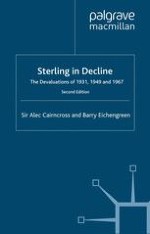2003 | OriginalPaper | Chapter
The 1967 Devaluation of Sterling
Authors : Sir Alec Cairncross, Barry Eichengreen
Published in: Sterling in Decline
Publisher: Palgrave Macmillan UK
Included in: Professional Book Archive
Activate our intelligent search to find suitable subject content or patents.
Select sections of text to find matching patents with Artificial Intelligence. powered by
Select sections of text to find additional relevant content using AI-assisted search. powered by
Long before 1967, the possibility that sterling might have to be devalued was widely entertained, though not often discussed in public. It came up from time to time in the 1950s, but without any indication that it had ever been seriously considered by the government. The Tribunal inquiring into alleged leaks before the raising of Bank rate to 7 per cent in September 1957 heard evidence from financial journalists that the Chancellor had told them of his intention ‘to represent most strongly’ at the Annual Meeting of the IMF in Washington that ‘the Government had no intention of devaluing the pound or allowing the margins of the rate to be flexible’.1 Harold Macmillan, musing on the economic situation at the beginning of 1962, reflected that if wage inflation continued ‘we might have to devalue’;2 and in writing to the Queen in March 1963 he described to her the school of thought that advocated a policy of ‘“Boom and do not mind busting”, i.e. devalue the pound or alternatively let it float’.3 But the only form of devaluation that he was willing to contemplate was a move to raise the price of gold, in default of action by the United States, by means of a concerted devaluation of the pound, mark and franc in the interests of increasing international liquidity.4
